Rough Guides Says That When you come to Vietnam in 2024, You Must Sample These 9 Vietnamese Foods.
According to Rough Guides magazine, Vietnam is one of the countries with great cuisine in Southeast Asia. Vietnamese cuisine is truly diverse and rich. In addition to famous dishes such as pho, broken rice and banh mi, there are some other dishes that are extremely delicious and worth trying when you come to Vietnam.
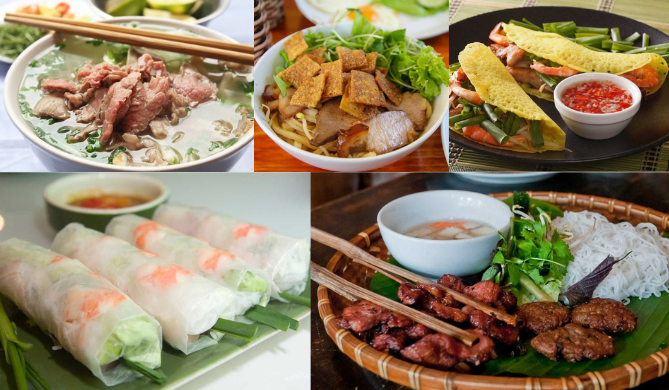
Eleanor Aldridge’s observation about Vietnamese cuisine echoes sentiments shared by many travelers who have experienced its diverse and unforgettable flavors. Rough Guides, as a renowned travel magazine, often provides valuable insights into various destinations, including their culinary offerings. Vietnamese cuisine’s uniqueness lies not only in its flavors but also in its rich history, regional diversity, and the freshness of its ingredients. From the aromatic broth of pho to the savory delights of banh mi, Vietnamese cuisine captivates the senses and leaves a lasting impression on those who indulge in its culinary delights.
Absolutely! One of the most captivating aspects of Vietnamese cuisine is its intricate balance of flavors. Whether you’re dining at a humble street stall or an upscale restaurant, you’ll find that each dish is meticulously crafted to incorporate a harmonious blend of salty, sweet, sour, and spicy elements. This balance creates a symphony of flavors that tantalizes the taste buds and keeps you coming back for more. Whether it’s the tangy nuoc mam dipping sauce accompanying spring rolls, the sweet and savory caramelized sauce in caramel pork, or the fiery kick of chili peppers in bun bo Hue, Vietnamese cuisine offers a sensory experience like no other. It’s this complexity and depth of flavors that make Vietnamese food so beloved by food enthusiasts around the world.
From the perspective of an international reporter, Eleanor Aldridge selected 9 Vietnamese dishes that tourists need to try when coming here
GỎI CUỐN – VIETNAMESE SPRING ROOLLS
Absolutely! Gỏi cuốn, or Vietnamese fresh spring rolls, is indeed a dish that you can find throughout Vietnam. Its popularity extends across regions, making it a ubiquitous choice on menus and street food stalls across the country.
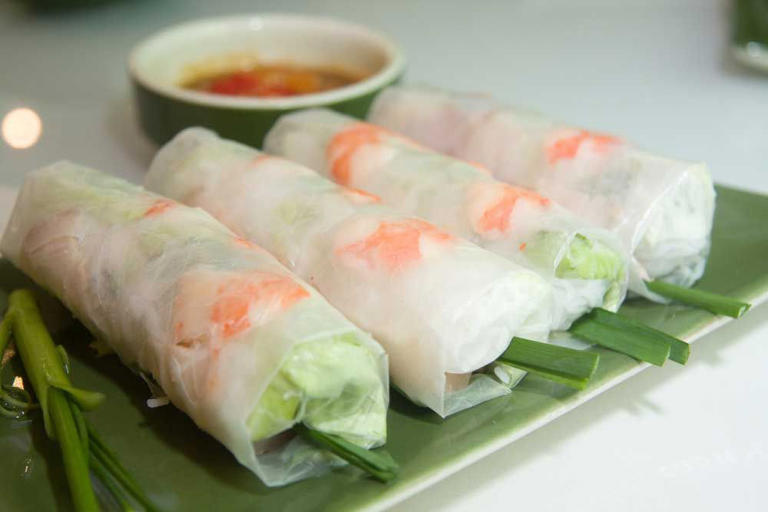
The beauty of gỏi cuốn lies in its versatility and freshness. As you mentioned, it’s typically filled with a combination of tender meat (often pork or shrimp), crunchy raw vegetables like lettuce, cucumber, and bean sprouts, along with fragrant herbs such as mint, cilantro, and Thai basil. The addition of onions and shredded fruits like green bananas or star fruit adds a delightful textural contrast and a touch of sweetness.
The rice paper used to wrap the ingredients gives the rolls their signature chewy texture and acts as a vessel to hold all the delicious fillings together. It’s also gluten-free, which makes it suitable for those with dietary restrictions.
The dipping sauces, whether it’s the classic fish sauce (nước mắm) or a sweet and sour fish sauce (nước chấm), enhance the flavors of the spring rolls, adding depth and richness to each bite. The combination of savory, sweet, and tangy flavors makes gỏi cuốn a refreshing and satisfying dish, perfect for enjoying on a hot day or as a light appetizer any time of the year.
BÁNH MÌ – Vietnamese Baguette
Absolutely! Bánh mì is indeed one of the most beloved and iconic street foods in Vietnam. Its origins can be traced back to the French colonial period in the 19th century when the French introduced their baguette bread to Vietnam. However, the Vietnamese people quickly adapted the baguette to suit their own tastes and culinary traditions, creating what we now know as bánh mì.
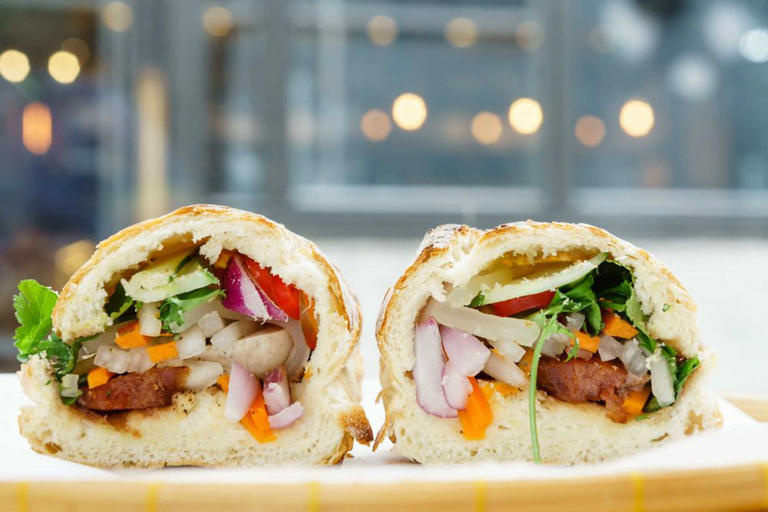
What makes bánh mì so special is its fusion of French and Vietnamese flavors and ingredients. The traditional bánh mì consists of a crispy French baguette, which is light and airy on the inside and crusty on the outside. It’s then filled with a variety of savory ingredients such as pâté, grilled or cold cuts of meat (often pork, chicken, or beef), pickled vegetables (carrots, daikon radish), fresh cucumber slices, cilantro, and sometimes sliced chili peppers for an extra kick.
The beauty of bánh mì lies in its versatility and affordability. It’s a portable and satisfying meal that can be enjoyed at any time of the day, whether as a quick breakfast on the go or as a hearty lunch or snack. Street vendors and bánh mì shops across Vietnam offer their own unique twists on the classic sandwich, making it a culinary adventure to try different variations as you travel throughout the country.
Rough Guides magazine said that Vietnamese bread is so delicious that it is learned and followed all over the world such as London, New York, Tokyo… to sell.
BÁNH XÈO – Vietnamese Pancake
The Rough Guides reporters have captured the essence of Vietnamese pancakes, known as bánh xèo, quite accurately! Bánh xèo are indeed famous for being large, affordable, and packed with a delicious filling of shrimp, meat (often pork or chicken), bean sprouts, and eggs.
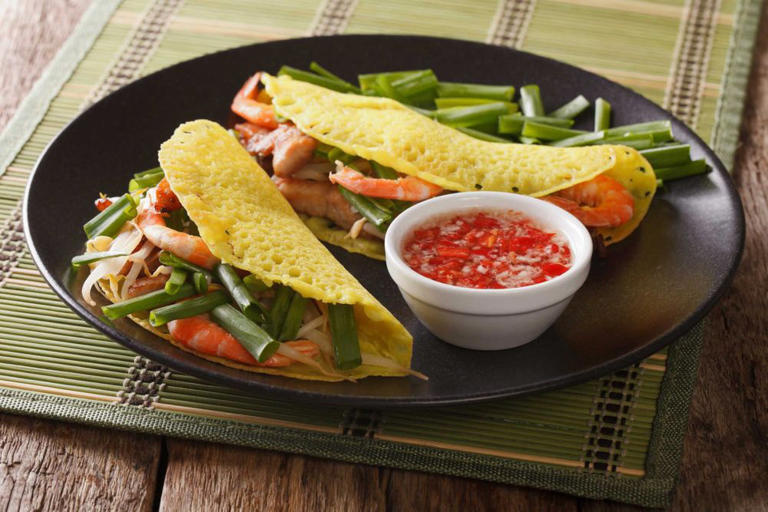
The name “bánh xèo” comes from the sizzling sound the batter makes when poured onto a hot skillet. The batter is made from a mixture of rice flour, turmeric powder (which gives it its distinctive yellow color), coconut milk, and water. This creates a thin, crispy pancake that encases the savory fillings.
Once cooked, the pancake is typically folded in half and served with a variety of fresh herbs and lettuce leaves. Diners can then wrap the pancake in lettuce and herbs before dipping it into a savory dipping sauce, usually made with fish sauce, lime juice, sugar, garlic, and chili.
Bánh xèo is a popular street food dish found throughout Vietnam, and it’s enjoyed for its delicious flavors, crunchy texture, and affordability. It’s a favorite among locals and tourists alike, offering a satisfying and flavorful dining experience that showcases the best of Vietnamese cuisine.
You can even carry it with you if traveling by train or bus. Rough Guides says it’s “the perfect side dish” for long journeys.
BÚN CHẢ
Bún chả is indeed a specialty of Hanoi and is readily available in the streets of the capital, as well as in restaurants and eateries across the city.
The dish typically consists of grilled pork patties and pork belly slices that are marinated with various spices and grilled over a charcoal stove until they are tender and caramelized. These grilled meats are then served alongside fresh rice vermicelli noodles (bún), along with a generous portion of fresh herbs such as mint, cilantro, and perilla leaves.
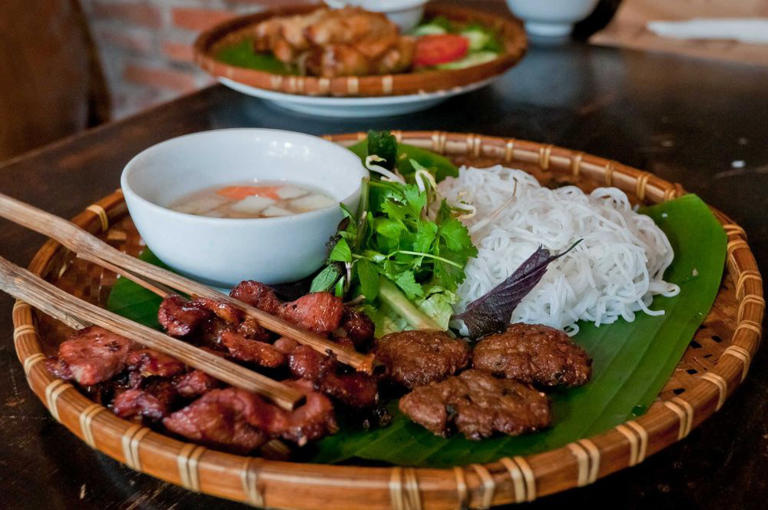
the essential accompaniment to bún chả is a dipping sauce made from fish sauce, vinegar, sugar, lime juice, garlic, and chili. This sauce adds a savory, tangy, and slightly sweet flavor to the dish, enhancing the overall taste experience.
Additionally, bún chả is often served with a plate of raw vegetables, such as lettuce, cucumber, and bean sprouts, which diners can use to wrap the grilled meats and noodles before dipping them into the sauce.
Bún chả is a quintessential Hanoi dish that offers a delightful combination of flavors and textures, making it a must-try for visitors exploring the culinary delights of the Vietnamese capital.
Many people compare the dish to meatballs or hamburgers, but Rough Guides magazine commented that bun cha is an attractive and non-hybrid combination of flavors.
PHỞ – Vietnamese Noodle Soup
Absolutely, pho is indeed a versatile dish that can be enjoyed at any time of the day, but it is particularly popular for breakfast in Vietnam.
Rough Guides describes: “A bowl of pho includes beef or chicken broth, flavored with ginger and coriander, added soft noodles and green onions, topped with pieces of chicken or beef. If you are vegetarian, you can choose tofu as the main ingredient.”
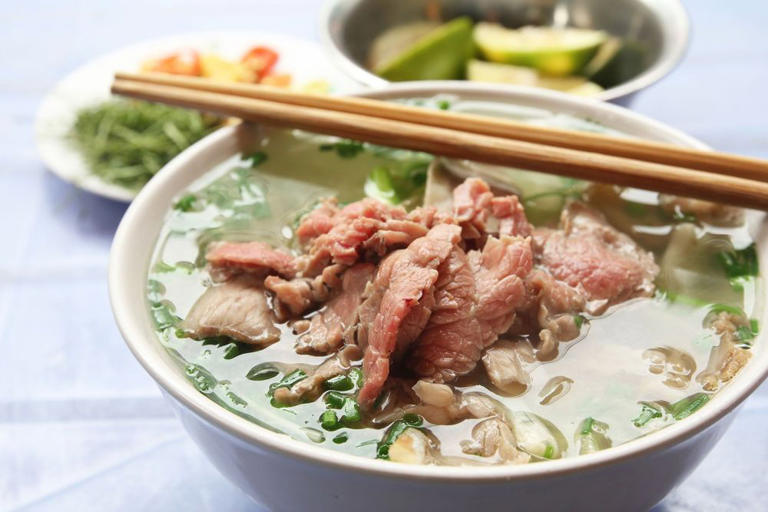
CAO LẦU – VIETNAMESE NOODLE SOUP
Indeed, Cao Lau is a signature dish of Hoi An, known for its unique combination of flavors and textures.
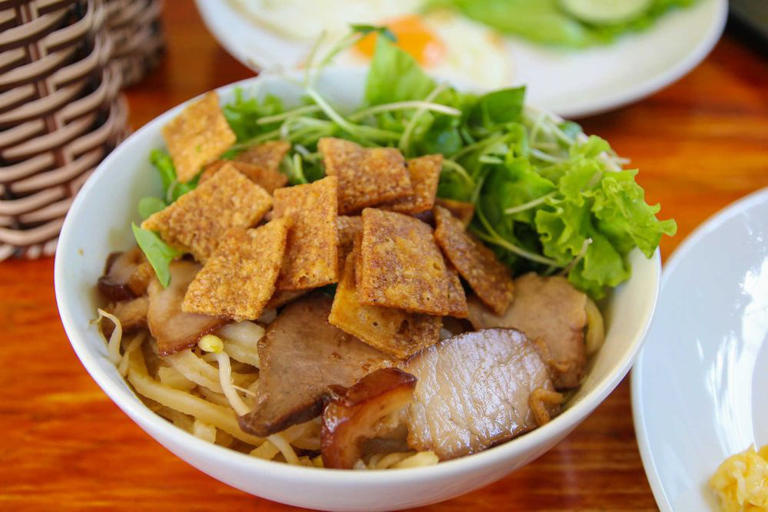
Here’s a closer look at what makes Cao Lau special:
- Thick Noodles: Cao Lau features thick rice noodles that have a distinctive texture, chewy yet tender, providing a satisfying base for the dish.
- Bean Sprouts: Fresh bean sprouts are often added to Cao Lau, providing a crunchy texture and a burst of freshness.
- Pork Rinds: Crispy pork rinds (or pork cracklings) are a common topping in Cao Lau, adding a savory crunch to each bite.
- Meats: Cao Lau typically includes slices of tender pork, which may be marinated and cooked in various ways to add depth of flavor to the dish.
- Raw Vegetables: Raw vegetables such as lettuce, herbs (like mint and basil), and sliced cucumbers are often served alongside Cao Lau, providing contrast and freshness.
- Peanuts: Crushed peanuts are often sprinkled on top of Cao Lau, adding a nutty flavor and a bit of texture.
- Rich Sauce: The dish is typically finished with a rich and flavorful sauce, which may vary depending on the recipe but often includes ingredients like soy sauce, fish sauce, garlic, and shallots. This sauce ties the ingredients together and adds depth of flavor to the dish.
- Grilled Rice Paper: Crispy grilled rice paper is sometimes served alongside Cao Lau, providing an additional element of texture and a fun way to enjoy the dish.
Cao Lau is a dish that reflects the culinary heritage of Hoi An, with influences from both Vietnamese and Chinese cuisines. Its unique combination of flavors, textures, and ingredients makes it a must-try for visitors exploring the vibrant food scene of Hoi An.
CHẢ CÁ – FISH CAKE
Grilled fish is indeed a popular and beloved dish in Hanoi cuisine, known for its simplicity and delicious flavors. The dish typically features fresh fish, often caught from nearby lakes or rivers, which is marinated with a combination of herbs, spices, and seasonings before being grilled over an open flame
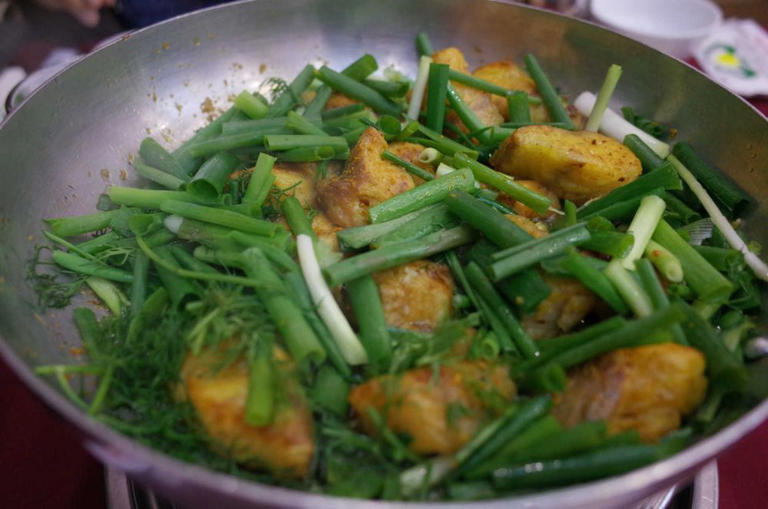
The main ingredients to make this dish are mainly from fish and fish, cut into pieces and fried in oil as soon as diners order. Fish cakes are fragrantly fried with onions, served with vermicelli, beans, and shrimp paste.
It’s no surprise that Rough Guides magazine identified grilled fish as one of the top dishes among Vietnamese seafood dishes. Its flavorful and aromatic profile, combined with its cultural significance, has made it a favorite not only in Hanoi but also throughout Vietnam. Whether you’re enjoying it at a local restaurant or preparing it at home, grilled fish is sure to delight seafood lovers and food enthusiasts alike.
MÌ QUẢNG – Vietnamese Noodle Soup
Mì Quảng noodles are indeed a specialty of Quang Nam province in Central Vietnam. This dish holds a significant place in the culinary landscape of the region and is cherished by locals and visitors alike.
Indeed, Mì Quảng noodles have evolved over time, with variations that include a wide array of ingredients to suit different tastes and preferences. While the traditional version of Mì Quảng may have been filled with shrimp, meat, and quail eggs, modern interpretations of the dish now incorporate a diverse range of ingredients, reflecting the creativity and innovation of chefs and home cooks.

Some of the additional ingredients that you might find in contemporary versions of Mì Quảng include:
- Frog: Frog legs may be added to Mì Quảng, providing a unique texture and flavor to the dish.
- Pork Trotters: Pork trotters, or pig’s feet, can add richness and depth to the broth of Mì Quảng, as well as providing succulent pieces of meat to enjoy.
- Ribs: Tender pork ribs may be included in Mì Quảng, adding a savory and satisfying element to the dish.
- Beef: Slices of beef, such as brisket or flank, can be added to Mì Quảng, offering a hearty and flavorful protein option.
- Chicken: Pieces of chicken, either grilled or poached, can be a delicious addition to Mì Quảng, providing a lighter alternative to pork or beef.
These additional ingredients contribute to the versatility of Mì Quảng, allowing for a range of flavor profiles and culinary experiences.
Similarly to Cao Lau, Mì Quảng noodles are typically served without a large amount of broth, with the ingredients arranged atop the noodles rather than submerged in soup. This presentation allows diners to appreciate the textures and flavors of the individual components, which may include raw vegetables, peanuts, and crispy rice paper (rice paper), providing contrasting textures and a delightful crunch to the dish.
CƠM TẤM – Steamed Broken Rice With Grilled Pork
Broken rice, known as cơm tấm in Vietnamese, is indeed a beloved dish enjoyed by many people in Vietnam, particularly in Ho Chi Minh City (formerly known as Saigon). While it’s true that broken rice originated from the lower classes in the past due to its affordability, it has since become a popular street food and staple dish enjoyed by people from all walks of life
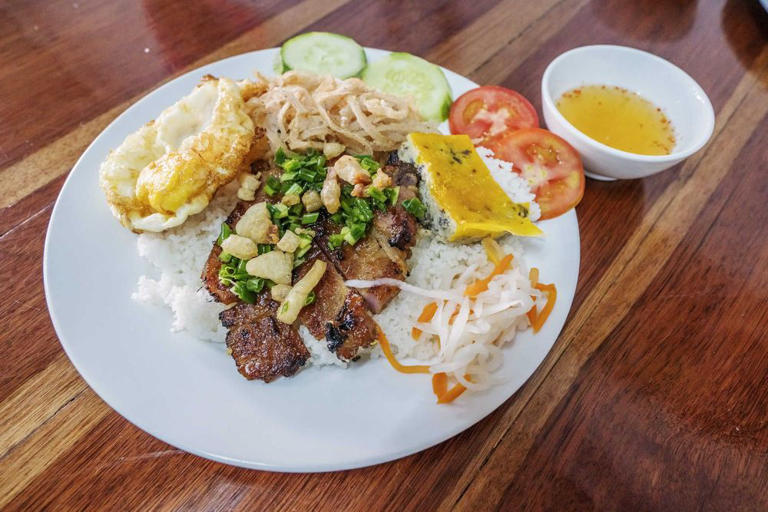
Broken rice is often served with a variety of accompaniments to create a flavorful and satisfying meal. Some of the common toppings and side dishes enjoyed with broken rice include:
- Grilled Pork: Tender and flavorful grilled pork, often marinated with a combination of savory and sweet spices, is a classic accompaniment to broken rice. The smoky aroma and caramelized flavor of the grilled pork complement the rice perfectly.
- Pork Skin: Shredded or thinly sliced pork skin, which adds a chewy texture and rich flavor to the dish, is another popular topping for broken rice. It provides a delightful contrast to the tender rice and meat.
- Spring Rolls: Crispy and savory spring rolls, filled with a mixture of ground pork, shrimp, vegetables, and vermicelli noodles, are often served alongside broken rice. They add an extra layer of flavor and crunch to the meal.
- Fried Eggs: A simple fried egg, with its creamy yolk and crispy edges, is a classic addition to broken rice. It adds richness and depth to the dish, making it more satisfying and hearty.
The flavor of this specialty dish will not be missed without a little fish sauce, fried onions, pickles and onion fat.


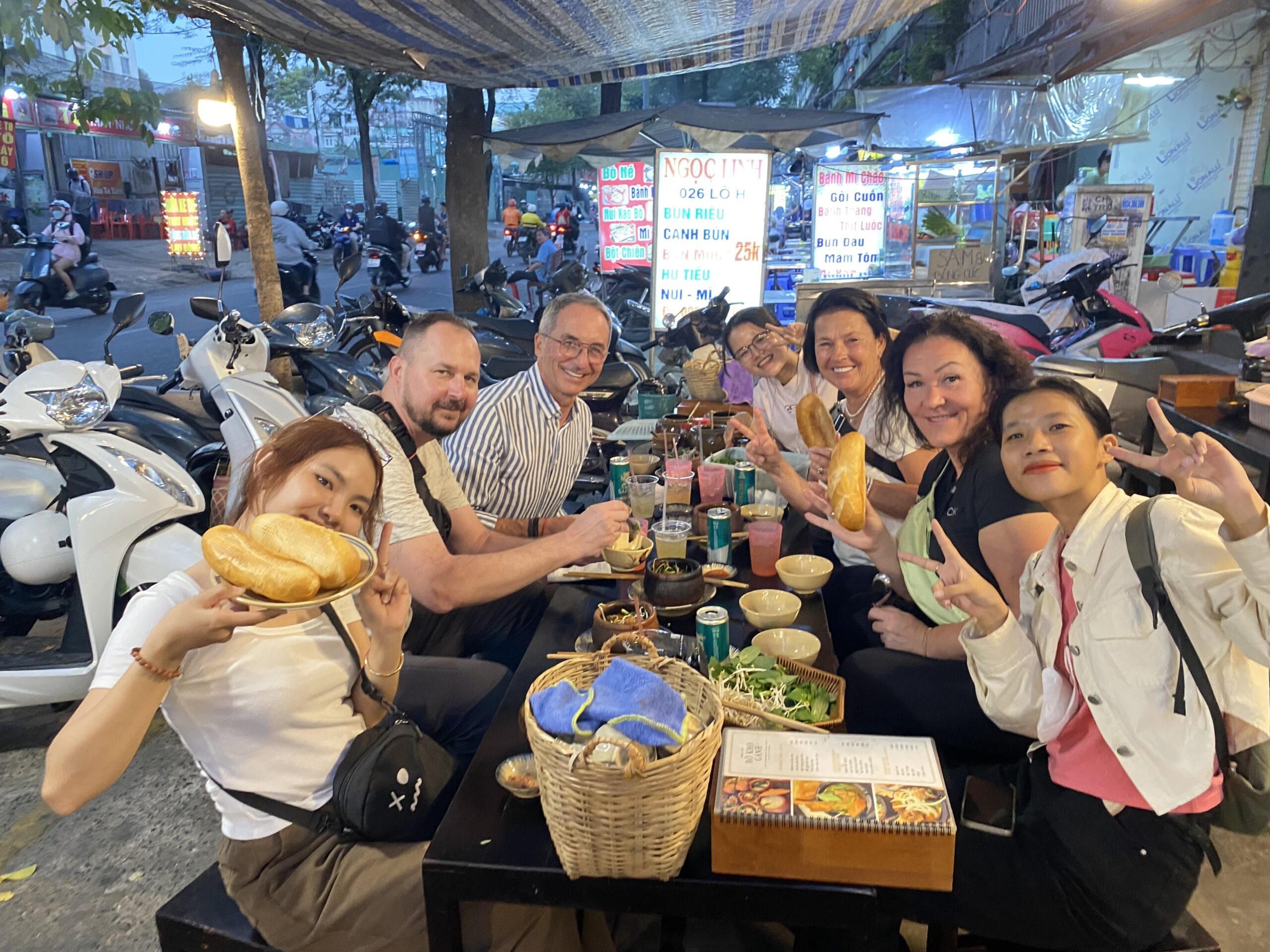
Leave a Reply